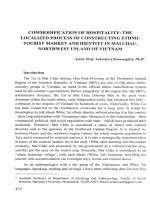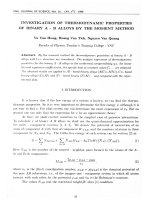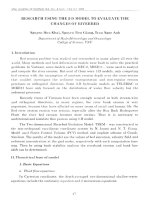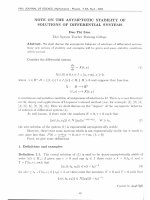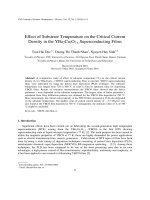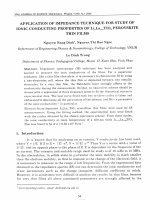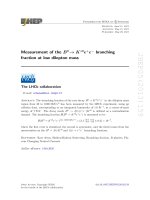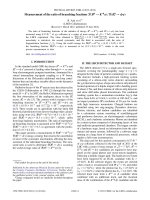DSpace at VNU: Application of the taraxerane-oleanane rearrangement to the synthesis of seco-oleanane triterpenoids from taraxerone
Bạn đang xem bản rút gọn của tài liệu. Xem và tải ngay bản đầy đủ của tài liệu tại đây (150.03 KB, 8 trang )
This article was downloaded by: [Ondokuz Mayis Universitesine]
On: 06 November 2014, At: 09:39
Publisher: Taylor & Francis
Informa Ltd Registered in England and Wales Registered Number: 1072954 Registered
office: Mortimer House, 37-41 Mortimer Street, London W1T 3JH, UK
Natural Product Research: Formerly
Natural Product Letters
Publication details, including instructions for authors and
subscription information:
/>
Application of the taraxerane–oleanane
rearrangement to the synthesis of secooleanane triterpenoids from taraxerone
a
ab
a
Phan Minh Giang , Vu Minh Trang , Phan Tong Son & Katsuyoshi
c
Matsunami
a
Faculty of Chemistry, VNU University of Science, Vietnam
National University, Hanoi, 19 Le Thanh Tong Street, Hanoi, Viet
Nam
b
VNU University of Education, Vietnam National University,
Hanoi, 144 Xuan Thuy Road, Hanoi, Viet Nam
c
Graduate School of Biomedical & Health Sciences, Hiroshima
University, 1-2-3 Kasumi, Minami-ku, Hiroshima 734-8553, Japan
Published online: 15 Sep 2014.
To cite this article: Phan Minh Giang, Vu Minh Trang, Phan Tong Son & Katsuyoshi Matsunami
(2015) Application of the taraxerane–oleanane rearrangement to the synthesis of seco-oleanane
triterpenoids from taraxerone, Natural Product Research: Formerly Natural Product Letters, 29:1,
64-69, DOI: 10.1080/14786419.2014.958737
To link to this article: />
PLEASE SCROLL DOWN FOR ARTICLE
Taylor & Francis makes every effort to ensure the accuracy of all the information (the
“Content”) contained in the publications on our platform. However, Taylor & Francis,
our agents, and our licensors make no representations or warranties whatsoever as to
the accuracy, completeness, or suitability for any purpose of the Content. Any opinions
and views expressed in this publication are the opinions and views of the authors,
and are not the views of or endorsed by Taylor & Francis. The accuracy of the Content
should not be relied upon and should be independently verified with primary sources
of information. Taylor and Francis shall not be liable for any losses, actions, claims,
proceedings, demands, costs, expenses, damages, and other liabilities whatsoever
or howsoever caused arising directly or indirectly in connection with, in relation to or
arising out of the use of the Content.
Downloaded by [Ondokuz Mayis Universitesine] at 09:39 06 November 2014
This article may be used for research, teaching, and private study purposes. Any
substantial or systematic reproduction, redistribution, reselling, loan, sub-licensing,
systematic supply, or distribution in any form to anyone is expressly forbidden. Terms &
Conditions of access and use can be found at />
Natural Product Research, 2015
Vol. 29, No. 1, 64–69, />
Application of the taraxerane –oleanane rearrangement to the synthesis of
seco-oleanane triterpenoids from taraxerone
Phan Minh Gianga*, Vu Minh Trangab, Phan Tong Sona and Katsuyoshi Matsunamic
Downloaded by [Ondokuz Mayis Universitesine] at 09:39 06 November 2014
a
Faculty of Chemistry, VNU University of Science, Vietnam National University, Hanoi, 19 Le Thanh Tong
Street, Hanoi, Viet Nam; bVNU University of Education, Vietnam National University, Hanoi, 144 Xuan
Thuy Road, Hanoi, Viet Nam; cGraduate School of Biomedical & Health Sciences, Hiroshima University,
1-2-3 Kasumi, Minami-ku, Hiroshima 734-8553, Japan
(Received 19 June 2014; final version received 21 August 2014)
Synthetic oleananes and seco-oleananes form a group of promising anti-inflammatory
and cancer chemopreventive agents with an excellent safety profile. These compounds
are usually prepared by semi-synthesis from natural oleanane triterpenoids. Since a
taraxer-14-ene was reported to be rearranged into an olean-12-ene under mild reaction
conditions, a rapid synthesis of seco-oleananes from taraxerone, which is a readily
available starting material, was explored by us. Treatment of taraxerone with
m-chloroperoxybenzoic acid gave 14,15-epoxy lactones, which underwent the
taraxerane –oleanane rearrangement leading to new seco-oleanane triterpenoids.
Keywords: taraxerone; Baeyer – Villiger
rearrangement; 3,4-seco-oleanane
oxidation;
taraxerane – oleanane
1. Introduction
Numerous natural pentacyclic compounds arise from squalene through a variety of cyclisation
modes under the catalytic action of oxidosqualene cyclases. The pentacyclic triterpenoids are
divided into many subgroups based on their carbon skeleton, of which lupane, oleanane and
ursane are distinguished classes because of their widespread occurrence and biological,
pharmacological or medicinal activities (Honda et al. 2000; Laszczyk 2009). A number of
publications have highlighted structure – activity relationships of oleananes, showing the
importance of chemical modifications in improving potency of the natural oleananes (Sun et al.
2006; Kazakova et al. 2014). Several 100 synthetic oleananes and seco-oleananes have been
synthesised and they are proved to be non-cytotoxic agents in the treatment of inflammatory
diseases and cancer chemoprevention (Finlay et al. 1997; Maitraie et al. 2009; Liby & Sporn
2012). In most reports, these compounds were semi-synthesised from natural oleananes. The
rearrangement of 2a,14a-diepoxytaraxerane into olean-12-ene-2a,3b,15a-triol under mild
reaction conditions reported by Banerji et al. (1999) inspired a new synthetic approach.
As taraxerone (1) is a readily available taraxerane triterpenoid and possesses a C-14/C-15 double
bond, new seco-A-ring oleananes can be prepared from 1 by the Baeyer – Villiger oxidation,
followed by the facile taraxerane – oleanane rearrangement described above. Oxidation of the
carbonyl group and epoxidation of the C-14/C-15 double bond give an epoxy lactone, which can
subsequently undergo the taraxerane – oleanane rearrangement and lactone-ring opening,
leading to seco-oleanane products (Scheme 1). We report herein the first synthesis of 3,4-secooleanane triterpenoids from taraxerone.
*Corresponding author. Email:
q 2014 Taylor & Francis
Natural Product Research
29
11
2
3
O
10
4
9
5
23 24
27
19
30
20
18
21
22
13 17
26
25
1
12
8 14 15
65
28
16
a
63.8%
O
7
O
b
H CO C
62.5% 3 2
OH
O
6
3
2
1
Downloaded by [Ondokuz Mayis Universitesine] at 09:39 06 November 2014
c 41.9%
H3CO2C
O
HO
d,e
99.3%
4
HO2C
HO
OH
5
Reagents: (a) MCBPA, CH2Cl2; (b) H2SO4, MeOH; (c) MCPBA, CH2Cl2, MeOH; (d) KOH, MeOH; (e) HCl, H2O
Scheme 1. Synthesis of 3 and 5 from 1.
2. Results and discussion
Treatment of taraxerone (1) with m-chloroperoxybenzoic acid (MCPBA) in CH2Cl2 solution at
room temperature led to the epoxidation of C-14/C-15 double bond and Baeyer – Villiger
oxidation of C-3 ketonic group. The HR-ESI-MS of the epoxy lactone product 2 showed a peak
at m/z 479.3493 ([M þ Na]þ), determining its molecular formula as C30H48O3. The 1H and 13C
NMR determined the introduction of the C-14/C-15 epoxide ring [dH 3.04 (1H, br d, J ¼ 6.5 Hz);
dC 57.2 and 68.6] on comparison with the NMR data of 14,15-epoxyepitaraxerol (Scheme S1).
The A-ring lactone was determined by the chemical shifts of two C-4 methyl groups [dH 1.43
(3H, s) and 1.46 (3H, s)], C-4 (dC 86.2) and the lactone carbonyl group (dC 174.9) (Maitraie et al.
2009; Tu et al. 2009).
The lactone ring of 2 was cleaved by treatment with a catalytic amount of H2SO4 in MeOH to
yield product 3. An acid-catalysed transesterification of 2 with MeOH might occur first, followed
by dehydration of C-4 tertiary hydroxyl group at room temperature. Independently, the skeletal
taraxerane –oleanane rearrangement took place to give 3 as the final product. Mechanistically, the
14,15-epoxide ring was protonated, followed by epoxide ring opening to generate a carbocation at
C-14 and C-15 hydroxymethine. Then 1,2-migration of C-13 methyl group to C-14, followed by
the cleavage of a H-12 proton afforded 3 (Scheme 2). The structure of 3 was characterised by NMR
spectroscopic data, which revealed the presence of a methyl ester [dH 3.65 (3H, s); dC 51.6 and
174.5] and C-4/C-23 double bond [dH 4.68 (1H, s) and 4.88 (1H, s); dC 113.6 and 147.3].
Characteristic signals of the C-12/C-13 double bond of the olean-12-ene [dH 5.31 (1H, t,
J ¼ 3.0 Hz); dC 123.2 and 145.9] (Seo et al. 1975) and a secondary hydroxymethine [dH 4.22
(1H, dd, J ¼ 11.5 Hz, 5.0 Hz); dC 68.4] were observed in the NMR spectra of 3.
On the other hand, the formation of 14,15-epoxy-3,4-seco-taraxerane (4) could be achieved
by treatment of 1 with MCPBA in a mixture of CH2Cl2 and CH3OH. Carbon-13 signals of B, C,
D and E rings were similarly observed for 2 and 4; however, A-ring was cleaved by
transesterification reaction, resulting in the appearance of two methyl groups at C-4 [dH 1.23
(3H, s) and 1.28 (3H, s)] and a methyl ester group [dH 3.66 (3H, s); dC 51.7 and 175.6] in the 1H
and 13C NMR spectra of 4. Compound 4 was then converted into its corresponding hydroxy acid
5. To prevent the possible dehydration of C-4 tertiary alcohol, 4 was hydrolysed in 5%
66
P.M. Giang et al.
CΗ3OH2
−CH3OH
H3CO2C
O
O
H3CO2C
O
..
O
O
H OCH3
2
H
H
..
CH3OH
H
H
CH3OH
H3CO2C
H3CO2C
Downloaded by [Ondokuz Mayis Universitesine] at 09:39 06 November 2014
OH
−CH3OH2
H3CO2C
OH
OH
3
Scheme 2. Plausible synthetic pathway of 3 from 2.
methanolic KOH (Tu et al. 2009). Then quick acidification of the hydrolysis product with 10%
aqueous HCl caused the taraxerane – oleanane rearrangement to afford 15-hydroxyolean-12-ene
(5). The NMR spectra of 5 showed signals of C-3 carboxylic acid (dC 176.3), hydroxy-bearing
C-4 (dC 75.7), two C-4 methyl groups [dH 1.25 (3H, s) and 1.29 (3H, s); dC 27.5 and 33.4] (Tu
et al. 2009), C-12/C-13 double bond of the newly formed olean-12-ene [dH 5.31 (1H, t,
J ¼ 3.0 Hz); dC 123.6 and 145.8] and C-15 hydroxymethine [dH 4.18 (1H, dd, J ¼ 11.5 Hz,
5.5 Hz); dC 68.3].
Since the 14,15-epoxide rings of 2 and 4 are a-oriented due to facile approach of the reagent
from the more exposed a-phase (Banerji et al. 1999), the ring opening led to the a-oriented C-15
secondary hydroxyl group. In the NOESY spectrum of 4 (Scheme S2), a NOESY correlation was
observed between H-15 (dH 3.04) and H3-26 (dH 1.15). As an evidence for the stereochemistry,
H-15b of 3 and 5 gave a typical diaxial coupling constant (J ¼ 11.5 Hz) with axial H-16a.
Subsequently, methyl migration from C-13 to C-14 occurred from the same a-phase, leading to
the a-orientation of C-14 methyl group.
3. Experimental
3.1. General experimental procedures
All reagents were products for synthesis. Taraxerone (1) was obtained by chromatographic
isolation from Euphorbia hirta and Mallotus barbatus plants. Optical rotations were measured
on a Jasco P-1030 digital polarimeter (Jasco, Tokyo, Japan). FT-IR spectra were recorded on a
Horiba FT-710 spectrophotometer (Horiba, Kyoto, Japan). HR-EI-MS were measured on a Jeol
JMS-T100GCV mass spectrometer (Jeol, Tokyo, Japan). HR-ESI-MS and HR-APCI-MS were
measured on an Applied Biosystems QSTAR XL mass spectrometer (Applied Biosystems,
Foster City, CA, USA). 1H (500 MHz) and 13C NMR (125 MHz) spectra were recorded on a
Bruker Avance 500 NMR spectrometer (Bruker, Billerica, MA, USA). Silica gel (0.040 –
0.063 mm) (Merck, Darmstadt, Germany) was used for column chromatography (CC). Thinlayer chromatography (TLC) was carried out on Merck TLC silica gel 60 F254 aluminium plates
(Merck, Darmstadt, Germany).
3.2. Baeyer –Villiger oxidation of taraxerone (1)
A mixture of 1 (97.2 mg, 0.229 mmol) and MCPBA (119 mg, 0.69 mmol) in CH2Cl2 (8 mL) was
stirred at room temperature for 72 h. The mixture was washed with aqueous NaHCO3 and
Downloaded by [Ondokuz Mayis Universitesine] at 09:39 06 November 2014
Natural Product Research
67
extracted with CH2Cl2 (20 mL £ 5). The CH2Cl2 extract was concentrated under reduced
pressure to give a crude product. The crude product was purified by CC on silica gel using nhexane – EtOAc 30:1, 19:1 and 9:1 to give 2 (66.6 mg, 0.146 mmol, 63.8%).
14,15-Epoxy-3,4-seco-taraxerane-3,4-lactone (2): white amorphous powder; ½a25
D þ 58.9
(c ¼ 0.14, CHCl3); IR (nmax, cm21): 1718, 1456, 1386, 1290, 1108; 1H NMR (CDCl3): d 0.79
(3H, s, 30-CH3), 0.86 (3H, s, 29-CH3), 1.05 (3H, s, 28-CH3), 1.08 (3H, s, 25-CH3), 1.12 (3H, s,
26-CH3), 1.18 (3H, s) (27-CH3), 1.43 (3H, s, 24-CH3), 1.46 (3H, s, 23-CH3), 3.04 (1H, br d,
J ¼ 6.5 Hz, H-15); 13C NMR (CDCl3): d 16.9 (C-25), 17.8 (C-11), 22.5 (C-6), 23.4 (C-27), 23.6
(C-26), 24.5 (C-30), 25.8 (C-23), 30.1 (C-16), 30.9 (C-20), 31.2 (C-28), 31.9 (C-2), 32.4 (C-24),
32.9 (C-17), 33.1 (C-7), 33.5 (C-29), 33.9 (C-12), 34.5 (C-21), 36.4 (C-13), 37.4 (C-1), 37.6 (C22), 39.2 (C-19), 39.6 (C-8), 40.9 (C-10), 46.2 (C-9), 49.5 (C-18), 54.9 (C-5), 57.2 (C-15), 68.6
(C-14), 86.2 (C-4), 174.9 (C-3); Positive-ion HR-ESI-MS: m/z 479.3493 (Calcd for C30H48O3Na
479.3496).
3.3. Synthesis of methyl 15-hydroxy-3,4-seco-olean-4(23),12-dien-3-oate (3)
Compound 2 (36.4 mg, 0.08 mmol) was dissolved in MeOH (5 mL). Concentrated H2SO4 (1
drop) was added and the reaction mixture was stirred at room temperature for 24 h. The mixture
was concentrated under reduced pressure, washed with aqueous NaHCO3 solution and extracted
with CH2Cl2 (20 mL £ 5). The CH2Cl2 extract was concentrated under reduced pressure to give
a crude product. The crude product was purified by CC on silica gel using n-hexane –EtOAc
50:1, 30:1 and 9:1 to give 3 (23.3 mg, 0.05 mmol, 62.5%).
Methyl 15-hydroxy-3,4-seco-olean-4(23),12-dien-3-oate (3): white amorphous powder;
21
½a24
D þ 102.7 (c ¼ 0.47, CHCl3); IR (nmax, cm ): 3444, 1734, 1636, 1465, 1384, 1299, 1176;
1
H NMR (CDCl3): d 0.87 (3H, s, 28-CH3), 0.88 (6H, s, 29-CH3, 30-CH3), 0.95 (3H, s, 25-CH3),
1.09 (3H, s, 26-CH3), 1.18 (3H, s, 27-CH3), 1.75 (3H, s, 24-CH3), 2.20 (1H, m, H-2a), 2.37 (1H,
ddd, J ¼ 16.0 Hz, 10.0 Hz, 6.0 Hz, H-2b), 3.65 (3H, s, -OCH3), 4.22 (1H, dd, J ¼ 11.5 Hz,
5.0 Hz, H-15), 4.68 (1H, s, H-23a), 4.88 (1H, s, H-23b), 5.31 (1H, t, J ¼ 3.0 Hz, H-12); 13C NMR
(CDCl3): d 17.4 (C-26), 19.5 (C-25), 19.8 (C-27), 23.5 (C-24), 23.6 (C-30), 23.8 (C-11), 24.7 (C6), 28.5 (C-1), 28.9 (C-28), 30.9 (C-20), 33.1 (C-8), 33.3 (C-29), 34.0 (C-7), 34.6 (C-2), 34.7 (C21), 36.7 (C-16), 37.7 (C-9), 37.8 (C-22), 39.3 (C-10), 40.9 (C-14), 46.3 (C-19), 47.8 (C-18),
48.1 (C-17), 50.1 (C-5), 51.6 (-OCH3), 68.4 (C-15), 113.6 (C-23), 123.2 (C-12), 145.9 (C-13),
147.3 (C-4), 174.5 (C-3); HR-EI-MS: m/z 470.37525 (Calcd for C31H50O3 470.37599); Positiveion HR-ESI-MS: m/z 493.3650 (Calcd for C31H50O3Na 493.3652); Positive-ion HR-APCI-MS:
m/z 471.3824 (Calcd for C31H51O3 471.3833).
3.4. Synthesis of methyl 14,15-epoxy-4-hydroxy-3,4-seco-taraxeran-3-oate (4)
A mixture of 1 (1 g, 2.358 mmol) and MCPBA (1.22 g, 7.07 mmol) in a mixture of CH2Cl2 and
CH3OH (8 mL) was stirred at 0 8C for 40 min., then at room temperature for 72 h. The mixture
was washed with aqueous NaHCO3 and extracted with CH2Cl2 (20 mL £ 5). The CH2Cl2 extract
was concentrated under reduced pressure to give a crude product. The crude product was purified
twice by CC on silica gel using n-hexane –EtOAc 30:1, 19:1 and 9:1 and n-hexane –EtOAc 15:1
and 9:1 to give 4 (482.1 mg, 0.988 mmol, 41.9%).
Methyl 14,15-epoxy-4-hydroxy-3,4-seco-taraxeran-3-oate (4): white amorphous powder;
21
1
½a25
D þ 28.8 (c ¼ 0.16, CHCl3); IR (nmax, cm ): 3497, 1723, 1445, 1386, 1204, 1177; H NMR
(CDCl3): d 0.79 (3H, s, 30-CH3), 0.86 (3H, s, 29-CH3), 1.01 (1H, m, H-19a), 1.04 (1H, m, H-7a),
1.05 (2H, m, H-9, H-22a), 1.05 (3H, s, 28-CH3), 1.06 (3H, s, 27-CH3), 1.08 (3H, s, 25-CH3), 1.09
(2H, m, H-6a, H-12a), 1.15 (3H, s, 26-CH3), 1.18 (1H, m, 16a), 1.21 (1H, m, H-19b), 1.23 (1H,
m, H-7b), 1.23 (3H, s, 24-CH3), 1.25 (1H, m, H-12b), 1.28 (3H, s, 23-CH3), 1.37 (1H, m, H-5),
68
P.M. Giang et al.
Downloaded by [Ondokuz Mayis Universitesine] at 09:39 06 November 2014
1.43 (1H, m, H-21a), 1.45 (1H, m, H-22b), 1.47 (1H, m, H-6b), 1.49 (1H, m, H-11a), 1.62 (1H,
m, H-2a), 1.64 (1H, m, H-11b), 1.97 (1H, m, H-18), 2.01 (1H, d, J ¼ 10.5 Hz, H-16b), 2.14 (1H,
m, H-1a), 2.17 (1H, m, H-21b), 2.38 (1H, ddd, J ¼ 15.5 Hz, 10.5 Hz, 4.5 Hz, H-2b), 2.53 (1H,
ddd, J ¼ 15.5 Hz, 10.5 Hz, 4.5 Hz, H-1b), 3.04 (1H, br d, J ¼ 6.5 Hz, H-15), 3.66 (3H, s,
-OCH3); 13C NMR (CDCl3): d 17.2 (C-11), 20.7 (C-25), 22.1 (C-6), 23.4 (C-27), 23.7 (C-26),
24.4 (C-30), 27.4 (C-24), 28.9 (C-1), 30.1 (C-16), 30.9 (C-20), 31.3 (C-28), 32.9 (C-17), 33.2
(C-12), 33.6 (C-29), 33.9 (C-23), 34.11 (C-7), 34.14 (C-2), 34.6 (C-21), 36.5 (C-13), 37.6
(C-22), 39.2 (C-19), 39.6 (C-8), 41.8 (C-18), 42.3 (C-10), 46.1 (C-9), 51.5 (C-5), 51.7 (-OCH3),
57.2 (C-15), 68.8 (C-14), 75.8 (C-4), 175.6 (C-3); Positive-ion HR-ESI-MS: m/z 511.3752
(Calcd for C31H52O4Na 511.3758).
3.5. Synthesis of 4,15-dihydroxy-3,4-seco-olean-12-en-3-oic acid (5)
Compound 4 (50 mg, 0.102 mmol) in 5% methanolic KOH (9.5 mL) was stirred at room
temperature for 72 h. The reaction mixture was concentrated under reduced pressure, added with
distilled water (18 mL), 10% aqueous HCl to pH 1 and extracted with CH2Cl2 (20 mL £ 5). The
CH2Cl2 extract was concentrated under reduced pressure to give 5 (48.2 mg, 0.102 mmol, 99.3%).
4,15-Dihydroxy-3,4-seco-olean-12-en-3-oic acid (5): white amorphous powder;
21
½a25
D þ 30.7 (c ¼ 0.12, CHCl3); IR (nmax, cm ): 3482, 3219, 1698, 1457, 1383, 1276, 1224,
1
1201, 1180; H NMR (CDCl3 þ CD3OD): d 0.87 (3H, s, 28-CH3), 0.88 (6H, s, 29-CH3, 30CH3), 1.07 (3H, s, 25-CH3), 1.12 (3H, s, 26-CH3), 1.16 (3H, s, 27-CH3), 1.25 (3H, s, 24-CH3),
1.29 (3H, s, 23-CH3), 2.31 (1H, m, H-2a), 2.48 (1H, m, H-2b), 4.18 (1H, dd, J ¼ 11.5 Hz, 5.5 Hz,
H-15), 5.31 (1H, t, J ¼ 3.0 Hz, H-12); 13C NMR (CDCl3 þ CD3OD): d 17.5 (C-26), 19.7 (C-27),
19.9 (C-25), 22.8 (C-6), 23.4 (C-11), 23.7 (C-30), 27.5 (C-24), 28.9 (C-28), 29.1 (C-1), 31.1 (C20), 33.1 (C-8), 33.3 (C-29), 33.4 (C-23), 34.4 (C-2), 34.7 (C-21), 35.3 (C-7), 36.8 (C-16), 37.6
(C-22), 39.0 (C-9), 41.0 (C-14), 41.3 (C-10), 46.4 (C-19), 47.8 (C-18), 48.2 (C-17), 51.4 (C-5),
68.3 (C-15), 75.7 (C-4), 123.6 (C-12), 145.8 (C-13), 176.3 (C-3); Positive-ion HR-ESI-MS: m/z
497.3597 (Calcd for C30H50O4Na 497.3601).
4. Conclusion
In addition to the traditional synthetic methodology of oleananes, a new approach to oleananes
from taraxeranes can be explored. By applying the facile taraxerane – oleanane rearrangement,
taraxerone was successfully converted into new seco-oleanane triterpenoids. The application of
this method to expand the existing library of synthetic oleananes is the subject of ongoing
investigations.
Supplementary material
Synthesis of 14,15-epoxytaraxerol, Schemes S1 and S2 and spectra of compounds 3 –5 relating
to this article are available online.
Funding
This research was funded by Vietnam National Foundation for Science and Technology Development
(NAFOSTED) [grant number 104.01-2012.10].
References
Banerji J, Chatterjee A, Saha M, Dhara KP, Kanrar S, Mukherjee P, Neuman A, Prange´ T. 1999. Reactions and
rearrangement of triterpenoids – 3-epitaraxerol and its transformation products. Indian J Chem. 38B:1322– 1330.
Downloaded by [Ondokuz Mayis Universitesine] at 09:39 06 November 2014
Natural Product Research
69
Finlay HH, Honda T, Gribble GW, Danielpour D, Benoit NE, Suh N, Williams C, Sporn MB. 1997. Novel A-ring cleaved
analogs of oleanolic and ursolic acids which affect growth regulation in NRP.152 prostate cells. Bioorg Med
Chem Lett. 7:1769–1772.
Honda T, Rounds BV, Bore L, Finlay HJ, Favaloro, Jr, FG, Suh N, Wang Y, Sporn MB, Gribble GW. 2000. Synthetic
oleanane and ursane triterpenoids with modified rings A and C: a series of highly active inhibitors of nitric oxide
production in mouse macrophages. J Med Chem. 43:4233–4246.
Kazakova OB, Giniyatullina GV, Medvedeva NI, Lopatina TV, Baikova IP, Tolstikov GA, Apryshko GN. 2014.
Synthesis and cytotoxicity of triterpene seven-membered cyclic amines. Russ J Bioorg Chem. 40:198–205.
Laszczyk MN. 2009. Pentacyclic triterpenes of the lupane, oleanane and ursane group as tools in cancer therapy. Planta
Med. 75:1549–1560.
Liby KT, Sporn MB. 2012. Synthetic oleanane triterpenoids: multifunctional drugs with a broad range of applications for
prevention and treatment of chronic disease. Pharmacol Rev. 64:972– 1003.
Maitraie D, Hung CF, Tu HY, Liou YT, Wei BL, Yang SC, Wang JP, Lin CN. 2009. Synthesis, anti-inflammatory, and
antioxidant activities of 18b-glycyrrhetinic acid derivatives as chemical mediators and xanthine oxidase
inhibitors. Bioorg Med Chem. 17:2785–2792.
Seo S, Tomita Y, Tori K. 1975. Carbon-13 NMR spectra of urs-12-ene and application to structural assignments of
components of Isodon japonicus Hara tissue cultures. Tetrahedron Lett. 1:7–10.
Sun H, Fang WS, Wang WH, Hu C. 2006. Structure-activity relationships of oleanane- and ursane-type triterpenoids. Bot
Stud. 47:339–368.
Tu HY, Huang AM, Wei BL, Gan KH, Hour TC, Yang SC, Pu YS, Lin CN. 2009. Ursolic acid derivatives induce cell
cycle arrest and apoptosis in NTUB1 cells associated with reactive oxygen species. Bioorg Med Chem.
17:7265–7274.
